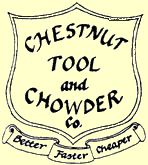
Clam
Clamps
(1-800-966-4837 )
P.O. Box 812
Holden, Maine 04429
Miter Clamps
for
Perfect Miters ...... Fast
An Article
"Perfect
Miters Every Time"
by Jim Chestnut
Article First Published
in "Fine Homebuilding
Magazine"
issue #164, July 2004
Edited by Jim Chestnut for web site publication.
All pictures are courtesy of "Fine Homebuilding Magazine", though most were not used in the orignial publication. Any inaccuracies, omissions, advertising, or inappropriate verbiage that may appear in THIS article did NOT appear in "Fine Homebuilding" and are solely the result of my own ineptitude and/or megalomania, greed, perversity, or any other of a wide range of diverse character flaws.
Page 3
If the stock has been primed on the job by the painters, we don’t let them stack it on their customary cupping and warping racks in the basement. We make sure they sticker it properly in a low humidity area – not the basement.
We like to cut our miters before cutting the stock to exact length, and prefer to have the outside edge of the casing against the fence when cutting them. This eliminates fuzzing and tearout on the inside edge of the miters - where it is most easily noticeable and hardest to sand. So when the material arrives, we orient it in the cutting room so a 16 footer does not have to be spun end for end in a 14' wide room before cutting..
Quick equipment check
Murphy seems to monkey with our equipment most often when we are moving it from one job to another. So we always cut a sample 90 degree miter after setting up the cut station to ensure that the result is square and that all the details line up. One of Murphy's favorite tricks is to move the adjustable pointer slightly off center on the chop saw scale, causing a perfectly square miter joint which has one miter longer than the other, and causing the details to get further and further out of alignment along the length of the miter.
Another thing that happens with miter saws over time is that the aluminum fences bend towards the rear of the saw up close to the blade. This happens even with saws where "jamming" the blade has happened infrequently simply because this area gets continuous stress. The bolts holding the fence in place are a fair distance away from the stress area because the turntable has to turn.
For instance, the innermost
bolts holding the fence on a Hitachi 15" are 13 and 13/16ths inches
apart -center to center. This problem can be quickly remedied by banging
the fences back parallel with a heavy framing hammer periodically, then
really reefing back down tightly on the bolts closest to the problem.
Don't be shy, but don't hit the fence high either.
After the necessary adjustments have been made, the cut man starts cutting
door leg miters - either lefts or rights- though I prefer starting with
rights
Measure Twice and Cut Once?
Absolutely not! We cut first and measure later for a number of reasons, and generally start with the door legs. By rough cutting the miters first, we get a lot of long material off the floor where it gets damaged. And once a bunch are cut, they can be slotted for biscuits at any time.
We cut as many as practical - perhaps enough rights (plus a few) to do all the doors upstairs on a large house. By placing a strip of blue painter's tape on the extension wings as a reference, we can quickly cut the door miters an inch or so long, and do not square the bottoms at this time. That way we do not have to repeatedly change the saw angle. Also, if the cut-man gets a "moon" cut, excessive tear out or any other unacceptable anomoly, he has plenty of stock left for another try or five.
In addition, if the "salvage"
cutoff from a right door leg is not long enough for another right door
leg, it may be long enough for a head (with the left side miter already
cut). It is easier, safer and more comfortable to accurately cut to a
pencil mark if the stock is to the left of saws with the handle and/or
motor to the right. This is why I prefer starting out by cutting right
door legs rather than lefts. The "salvage" heads already have
the left side miter cut, meaning the "money cut" will be made
with the stock to the left. Now the cut man will finish rough cutting
the remaining heads from fresh stock.
While the cut man is cutting, the job choreographer or "boss"
is insuring that the rest of the crew are not standing around with their
thumbs turning brown. That they are hanging doors, installing window stools,
cutting protruding sheet rock back from door and window jambs, laying
out panelling, etc.
After finishing the heads, he rotates the chop saw to the other side, makes a cut which he checks with a couple previously cut right sides, and starts over again with the left door legs.
After these have been cut, hopefully, enough doors have been hung to make it worthwhile to start getting some measurements. If not, the cut man can start on the windows, slot miters he has already cut for biscuits, cut back drywall or take an early lunch break. Hopefully again, the door shop that pre-hung the doors made all the jambs identical. If not, each head will have to be measured, marked using stops, then cut without stops. Or if there are not that many, simply measured and cut traditionally.